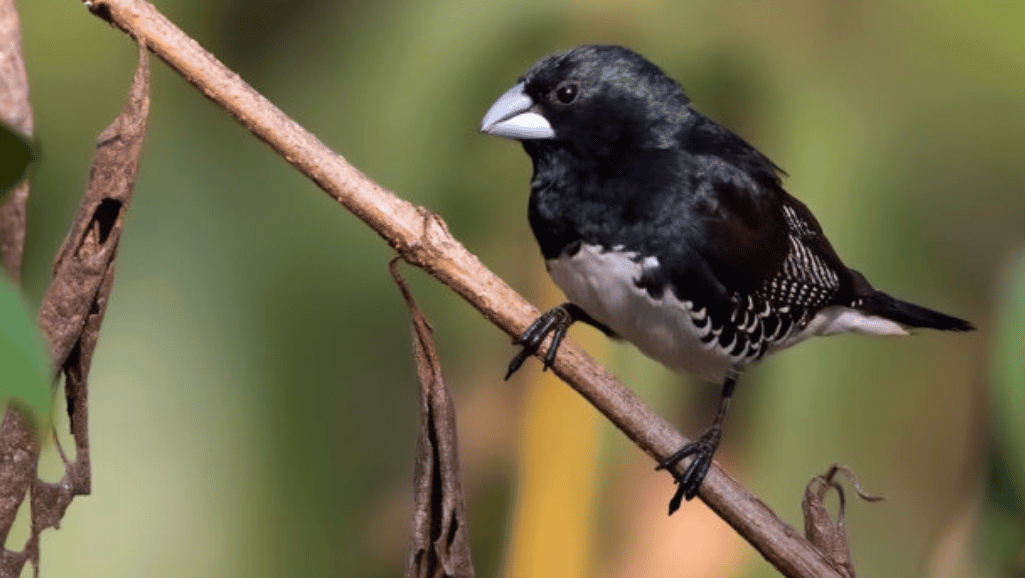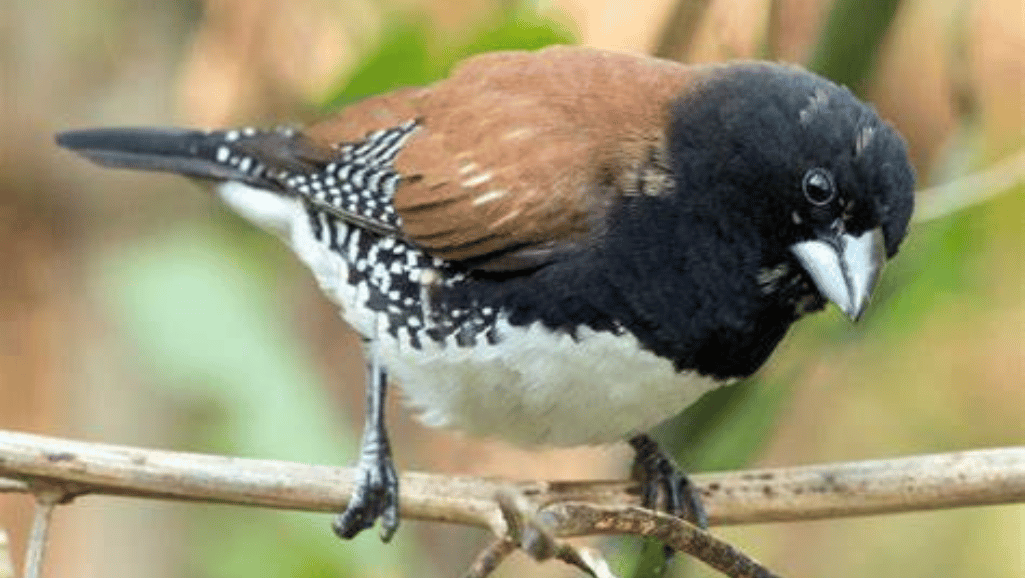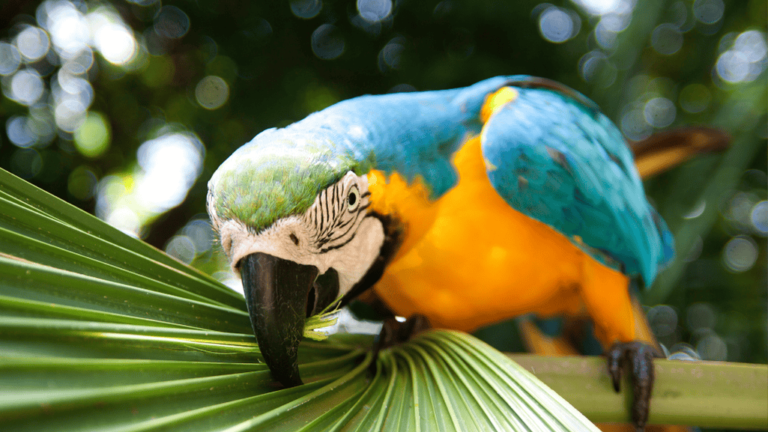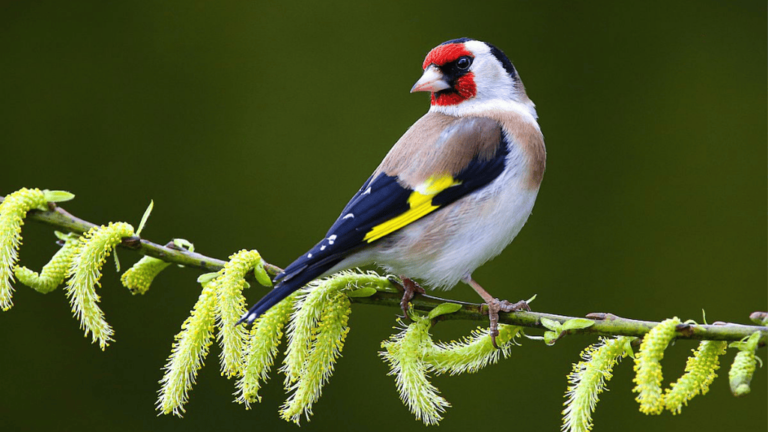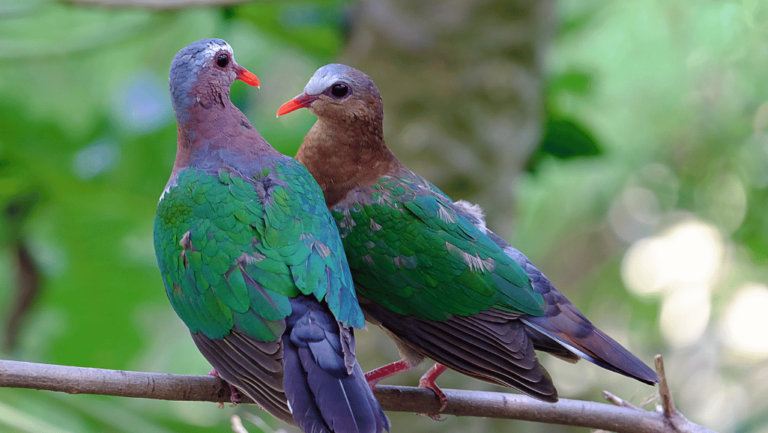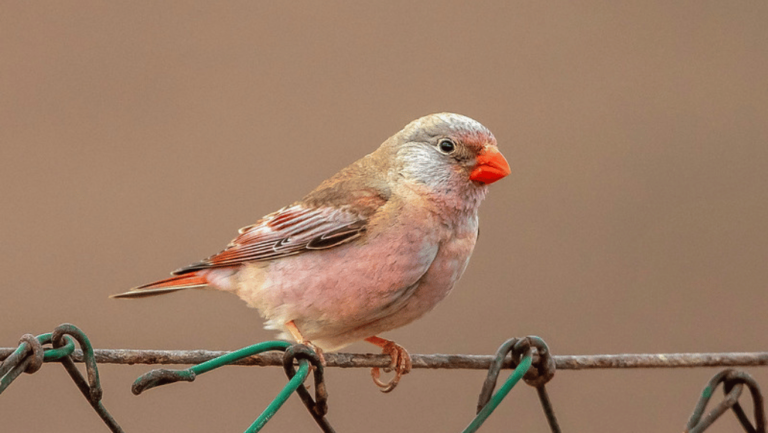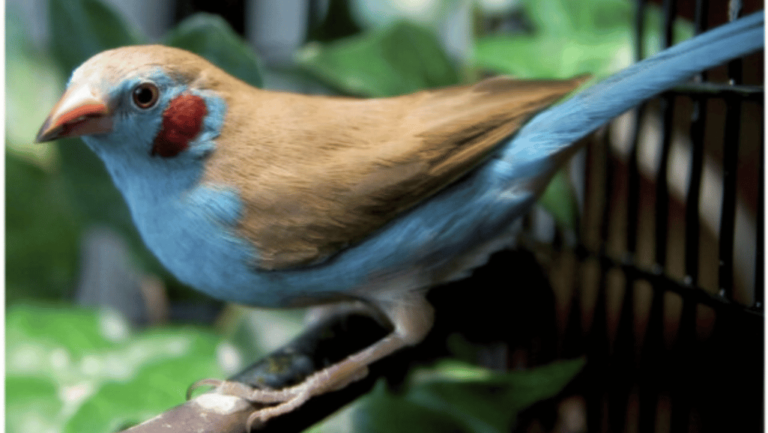Welcome to our exploration of the Black-White Mannikin Finch, a captivating bird species known for its monochrome plumage. As avian biodiversity enthusiasts, we delve into the fascinating world of this distinctive finch, examining its habitat, behavior, conservation status, and more.
Key Takeaways:
- The Black-White Mannikin Finch showcases a striking black-and-white coloration, with variations in the presence of white barring on the wings and tail.
- This species is typically found in forested areas, moist woodlands, and gardens, often in the vicinity of seeding grass patches.
- As a seed-eating songbird, the Black-White Mannikin Finch has adapted to forage on grass seeds and other small seeds.
- Conservation efforts are crucial to protect this species’ habitat and ensure its long-term survival, despite its current classification as a species of Least Concern.
- While the Black-White Mannikin Finch is a resident bird species, it may exhibit local movements and seasonal variations in abundance within its range.
Description and Behavior
The Black-White Mannikin Finch is a small finch species known for its striking monochrome plumage. With its black wings, tail, and head, and white barring on the wings and tail, this bird stands out in its natural habitat. The intensity of the white barring can vary, ranging from sparse spotting to completely black wings and tail.
Juvenile Black-White Mannikin Finches display a more subdued appearance, with a drab and brown coloration. However, they can be easily identified through their association with the adult birds.
This species is typically found in forested areas, moist woodlands, and gardens, particularly in locations with seeding grass. It has adapted well to various habitats, allowing it to thrive in different environments. Black-White Mannikin Finches exhibit social behavior and are often seen in small flocks, moving together as they forage and explore their surroundings.
One distinctive characteristic of the Black-White Mannikin Finch is its descending call, which sets it apart from other bird species. This unique vocalization adds to the charm and allure of this remarkable finch.
Summary of Description and Behavior
| Physical Traits | Behavior and Habits | Habitat |
|---|---|---|
| Black wings, tail, and head | Forms small flocks | Forests, moist woodlands, gardens |
| White barring on wings and tail | Distinctive descending call | Areas with seeding grass |
| Variations in white barring |
Distribution and Habitat
The Black-White Mannikin Finch, a remarkable African finch species, is widely distributed across the continent. Its range extends from Guinea-Bissau in the west to Somalia in the east, and from northern Angola to Tanzania in the south. This finch showcases its adaptability by thriving in diverse habitats, including forests, moist woodlands, and gardens. It is particularly fond of open grasslands and the edges of cultivated areas. Therefore, the Black-White Mannikin Finch can be found in various environments, bringing its captivating presence to ecosystems throughout Africa.
To give you a clearer idea of the distribution and habitat preferences, here is a breakdown:
| Region | Habitats |
|---|---|
| West Africa | Forests, grasslands, gardens |
| East Africa | Wooded areas, grassy landscapes |
| Central Africa | Savannas, open woodlands |
| Southern Africa | Coastal thickets, bushveld regions |
These are just a few examples, as the Black-White Mannikin Finch’s habitat preferences can vary within its extensive distribution across the African continent.
Here’s a captivating image of the Black-White Mannikin Finch in its natural habitat:
With its wide-ranging distribution and adaptability to different habitats, the Black-White Mannikin Finch adds a touch of charm and elegance to Africa’s avian biodiversity.
Feeding and Breeding Habits
The Black-White Mannikin Finch, a seed-eating songbird, has distinctive feeding habits and intriguing breeding behavior. Let’s explore these fascinating aspects in more detail:
Feeding Habits
The Black-White Mannikin Finch is primarily a seed-eating bird, with a preference for grass seeds and other small seeds. It forages on the ground and in low vegetation, using its specialized bill to extract the seeds. This adaptability allows the finch to thrive in various habitats, from forested areas to gardens. The finch’s seed-eating behavior plays a crucial role in its diet and overall survival.
Breeding Habits
During the breeding season, male Black-White Mannikin Finches engage in elaborate courtship displays to attract females. These displays often involve singing, wing flapping, and other unique behaviors. Once a pair has formed, they begin the nesting process. The finches construct their nests in low shrubs or trees, using twigs, grass, and other plant materials. The female then lays a clutch of eggs, which are incubated by both parents taking turns. Once the eggs hatch, the finches care for the nestlings by feeding them a diet consisting of regurgitated seeds.
Understanding the feeding and breeding habits of the Black-White Mannikin Finch provides valuable insights into its lifecycle and contributes to the broader knowledge of avian behavior and ecology.
The image above showcases the beauty of the Black-White Mannikin Finch, with its monochrome plumage and distinctive features.
Conservation Status
The Black-White Mannikin Finch, a beloved member of the finch family, currently holds the conservation status of Least Concern according to the International Union for Conservation of Nature (IUCN). This classification indicates that the species is not considered to be facing a high risk of extinction.
However, it is important to note that like many bird species, the Black-White Mannikin Finch may still face threats in certain regions. Habitat loss, degradation, and fragmentation can pose significant challenges to its survival. The conservation efforts dedicated to this beautiful bird and its habitat play a pivotal role in ensuring its long-term existence.
Avian conservation efforts strive to protect threatened bird species, and the Black-White Mannikin Finch is no exception. Preserving its natural habitat, conserving diverse ecosystems, and promoting awareness of the finch’s significance are key components of avian conservation.
In addition to addressing immediate threats to this species, a comprehensive approach focuses on sustainable development practices that prioritize the conservation of biodiversity. By safeguarding the Black-White Mannikin Finch and its habitat, we can contribute to the overall health and resilience of our planet’s ecosystems.
| Threats to the Black-White Mannikin Finch | Conservation Efforts |
|---|---|
|
|
Conservation initiatives that involve stakeholders at the local, national, and international levels contribute to the preservation of threatened species like the Black-White Mannikin Finch. By supporting avian conservation efforts, individuals, organizations, and communities can make a lasting impact on the future of this remarkable bird species.
Migration Patterns
The Black-White Mannikin Finch is a resident bird species within its range and does not undertake long-distance migrations. However, it exhibits local movements and seasonal variations in abundance. These patterns of movement can be influenced by factors such as food availability and breeding behavior. To comprehensively understand the migration patterns of the Black-White Mannikin Finch, further research is required.
Although black in coloration, the Black-White Mannikin Finch’s migratory patterns are quite different from the well-known Blackbird species that undertake long-distance migrations. While the Blackbird travels thousands of miles across continents, the Black-White Mannikin Finch is content with shorter, more localized movements.
- Local movements: The Black-White Mannikin Finch can exhibit local movements within its range, often in search of available food sources or suitable nesting sites. These movements can correspond to changes in food availability, seasonal variations, or environmental conditions.
- Seasonal variations: The abundance and presence of the Black-White Mannikin Finch can vary between seasons, with fluctuations in population numbers noted during different times of the year. These variations can result from factors such as changes in food availability, breeding patterns, or climatic conditions.
Factors influencing migration
Various factors influence the migration patterns of the Black-White Mannikin Finch:
- Food availability: Availability of food resources, specifically grass seeds and small seeds that the finch feeds on, can play a crucial role in determining the movement patterns of the species. As food sources deplete in a particular area, the finches may move to other locations in search of sustenance.
- Breeding behavior: Breeding behavior can also contribute to the migration patterns of the Black-White Mannikin Finch. The need for suitable breeding habitats with ample resources may trigger localized movements.
Migration research
While the Black-White Mannikin Finch is not known for long-distance migrations like some other bird species, research is ongoing to deepen our understanding of its migration patterns. Scientists and ornithologists are conducting studies that involve tracking the movements of individual finches and monitoring their patterns and behaviors.
| Research methods | Findings |
|---|---|
| Radio tracking | Indicated localized movements of individual finches within their habitat range, patterns influenced by food availability and breeding behavior. |
| Observational studies | Noted seasonal variations in abundance and presence of Black-White Mannikin Finches, providing insights into their movements in different times of the year. |
Taxonomy and Nomenclature
The Black-White Mannikin Finch, scientifically known as Spermestes bicolor, is a member of the family Estrildidae within the order Passeriformes. Its taxonomy and nomenclature provide important insights into the classification and identification of this unique bird species.
In the scientific name, the genus Spermestes refers to the finch’s seed-eating nature, emphasizing its dietary habits. The species name bicolor highlights the distinctive black-and-white plumage that defines the Black-White Mannikin Finch.
| Order | Family | Genus | Species |
|---|---|---|---|
| Passeriformes | Estrildidae | Spermestes | bicolor |
The taxonomy and nomenclature of bird species play a crucial role in understanding the evolutionary relationships, behavior, and ecological significance of avian populations. They enable scientists and bird enthusiasts alike to identify and classify different bird species accurately, contributing to our knowledge of avian biodiversity.
Similar Species and Identification
The Black-White Mannikin Finch shares some similarities with other finch species, including the Bronze Mannikin. However, it can be easily distinguished by a few key characteristics. The Black-White Mannikin Finch has an all-blue bill, whereas the Bronze Mannikin does not. Additionally, the Black-White Mannikin Finch never shows a brown back, whereas the Bronze Mannikin may display some brown coloring. These distinct features make it relatively simple to identify the Black-White Mannikin Finch.
The primary identification of the Black-White Mannikin Finch is based on its monochrome plumage. It has a black head, wings, and tail, accompanied by variable white barring on the wings and tail. The degree of white barring can range from sparse spotting to completely black wings and tail. Although juvenile Black-White Mannikin Finches may appear more drab and brown in color, they can be recognized by their association with adults.
Here is a summarized comparison between the Black-White Mannikin Finch and the Bronze Mannikin:
| Characteristic | Black-White Mannikin Finch | Bronze Mannikin |
|---|---|---|
| Bill Color | All-blue | Not all-blue |
| Back Color | No brown back | Possible brown back |
The image above showcases the stunning plumage of the Black-White Mannikin Finch, emphasizing its black-and-white coloration.
Sightings and Observations
The Black-White Mannikin Finch, a captivating African bird species, has been the subject of numerous sightings and observations across its range. Birdwatchers and enthusiastic nature lovers have reported fascinating encounters with this unique finch in various habitats, ranging from forested areas to moist woodlands and gardens.
These sightings have been instrumental in expanding our knowledge of the distribution, behavior, and ecology of the Black-White Mannikin Finch. By documenting their presence in different landscapes, researchers and birdwatching enthusiasts contribute valuable information that aids in understanding the species’ habitat preferences and overall patterns of occurrence.
Observations of Black-White Mannikin Finches in forested areas highlight their ability to adapt and thrive in diverse ecosystems. These sightings demonstrate the species’ resilience and their affinity for habitats characterized by patches of seeding grass.
Birdwatchers and researchers have also noted the sociable nature of Black-White Mannikin Finches. These finches, often seen in small flocks, engage in intriguing social behaviors. Their distinctive descending call adds to the allure of encountering these birds in the wild.
The collective efforts of birdwatchers and researchers in recording these sightings play a crucial role in building our understanding of the Black-White Mannikin Finch. By sharing their experiences and observations, they contribute to the conservation and protection of this captivating bird species and its habitat.
Below is a table summarizing some notable sightings and observations of the Black-White Mannikin Finch:
| Location | Date | Sighting Details |
|---|---|---|
| Kenya | May 2021 | A flock of Black-White Mannikin Finches spotted foraging among grassy areas in Nairobi National Park. |
| South Africa | September 2021 | An observer noted the distinctive call of the Black-White Mannikin Finch coming from a forested area in Mpumalanga. |
| Tanzania | July 2022 | Several breeding pairs of Black-White Mannikin Finches observed building nests in shrubs near Arusha. |
These sightings and records provide invaluable insights into the distribution and behavior of the Black-White Mannikin Finch, contributing to our ongoing efforts to protect and conserve this remarkable African bird species.
Cultural Significance
Birds have always held a special place in human culture, and the Black-White Mannikin Finch is no exception. In African folklore and beliefs, birds have been associated with various symbolic meanings, representing qualities such as freedom, beauty, and spiritual connection. The presence of the Black-White Mannikin Finch in local ecosystems adds to the rich tapestry of bird folklore and cultural significance.
African Bird Folklore
In different African cultures, birds have been revered and admired for their stunning plumage and remarkable behaviors. They are often considered messengers between the natural and spiritual worlds, carrying prayers and wishes to higher realms. The Black-White Mannikin Finch, with its distinctive black-and-white coloration, may symbolize the duality of life and the balance between opposing forces.
Furthermore, birds are believed to possess mystical qualities and are sometimes associated with powerful deities or ancestral spirits. They are seen as omens and bringers of good fortune. The Black-White Mannikin Finch, with its elegant appearance and melodious call, may inspire a sense of beauty and awe in those who encounter it, evoking a deep connection to the natural world.
Avian Inspiration
Birds, including the Black-White Mannikin Finch, have inspired various forms of artistic expression across Africa. Their graceful movements, vibrant colors, and mesmerizing songs have influenced traditional music, dance, and storytelling. The intricate patterns of their plumage have been incorporated into tribal designs, textiles, and pottery, reflecting the cultural significance and reverence for these creatures.
Furthermore, the Black-White Mannikin Finch and other birds have been featured in African literature and oral traditions, often serving as metaphors for human emotions and experiences. Their presence in poems, fables, and myths adds depth and symbolism to these narratives, highlighting the deep connection between birds and the human imagination.
| African Bird Folklore | Avian Inspiration |
|---|---|
|
|
Conservation Efforts and Importance of Research
Conservation efforts are crucial for preserving the Black-White Mannikin Finch and its habitat. By conducting focused research, we can gain a deeper understanding of the species’ ecology, behavior, and conservation needs. This knowledge enables us to develop effective conservation strategies and mitigate potential threats to not only the Black-White Mannikin Finch but also other bird species.
Avian research plays a vital role in identifying population dynamics, habitat requirements, and the impacts of human activities on bird species. Through comprehensive studies, scientists can gather valuable data that informs conservation efforts and helps us protect these incredible creatures. By studying the Black-White Mannikin Finch, we can build a solid foundation for effective management and conservation actions.
Conservation Strategies
Developing successful conservation strategies requires a multi-faceted approach that addresses the various threats faced by the Black-White Mannikin Finch. These strategies may include:
- Preserving and restoring natural habitats: Protecting and restoring the diverse habitats that the Black-White Mannikin Finch relies on is critical. This involves conserving forests, woodlands, and gardens with seeding grass, ensuring they remain intact and free from destructive human activities.
- Collaborative conservation efforts: Engaging with local communities, organizations, and governments is essential for implementing effective conservation initiatives. By working together, we can create sustainable solutions that benefit both the Black-White Mannikin Finch and local communities.
- Education and awareness programs: Raising awareness about the importance of bird species conservation and the role of the Black-White Mannikin Finch within ecosystems can encourage individuals and communities to actively participate in conservation efforts.
- Monitoring and research: Continuous monitoring and research efforts are crucial for understanding population trends, identifying threats, and evaluating the effectiveness of conservation actions. This data allows us to adapt strategies accordingly and make informed decisions.
The Importance of Research
Research on the Black-White Mannikin Finch and other bird species contributes to our knowledge of avian biodiversity and enhances our understanding of ecosystem dynamics. Here are some reasons why avian research is vital:
- Conservation planning: Research helps identify priority areas for conservation and informs decision-making processes related to the protection of bird species and their habitats.
- Ecosystem health: By studying bird species like the Black-White Mannikin Finch, researchers gain insights into the overall health and functioning of ecosystems. Birds play crucial roles as seed dispersers, pollinators, and indicators of environmental conditions.
- Climate change impacts: Research helps assess the impacts of climate change on bird populations and their habitats. This information is crucial for developing adaptation strategies and implementing measures to mitigate the effects of a changing climate.
- Species-specific conservation actions: Detailed research enables the development of targeted conservation actions tailored to the specific needs and requirements of bird species like the Black-White Mannikin Finch. This approach increases the effectiveness of conservation efforts.
Avian research provides the necessary foundation for evidence-based conservation strategies and decisions. It empowers us to protect the Black-White Mannikin Finch and ensure the long-term survival of bird species worldwide.
Conclusion
The Black-White Mannikin Finch is a captivating bird species known for its monochrome plumage and unique behavior. Found across various habitats in Africa, from forests to gardens, this species showcases the beauty and biodiversity of avian life on the continent. While it currently holds a conservation status of Least Concern, it is essential that we prioritize efforts to protect its habitat and ensure its long-term survival.
Research and conservation initiatives are critical in understanding the ecology and behavior of the Black-White Mannikin Finch, as well as mitigating potential threats. By studying its population dynamics, habitat requirements, and the impacts of human activities, we can develop effective strategies to safeguard this remarkable bird species and foster a sustainable coexistence between humans and nature.
In this article, we have explored the Black-White Mannikin Finch’s distinctive features, distribution, feeding and breeding habits, cultural significance, and the importance of ongoing research and conservation efforts. By raising awareness and understanding of the importance of preserving this species and its habitat, we can contribute to a healthier and more balanced ecosystem for both birds and humans alike.
In summary, the Black-White Mannikin Finch’s striking appearance and behavior make it a truly captivating bird species. With its widespread distribution in Africa, it symbolizes the rich avian biodiversity of the continent. While it currently faces no immediate threat to its existence, it is crucial that we remain vigilant and proactive in ensuring its continued presence in our world. By valuing and protecting this fascinating bird, we embrace our responsibility as stewards of the natural world and contribute to the conservation of our planet’s diverse ecosystems.
FAQ
What is the Black-White Mannikin Finch?
The Black-White Mannikin Finch is a small finch species known for its monochrome plumage, with black wings, tail, and head, and white barring on the wings and tail.
Where is the Black-White Mannikin Finch found?
The Black-White Mannikin Finch is distributed across Africa, from Guinea-Bissau in the west to Somalia in the east, and south to northern Angola and Tanzania.
What does the Black-White Mannikin Finch eat?
The Black-White Mannikin Finch is a seed-eating songbird that predominantly feeds on grass seeds and other small seeds.
What are the breeding habits of the Black-White Mannikin Finch?
During the breeding season, which varies depending on the region, male Black-White Mannikin Finches engage in courtship displays to attract females. They build nests in low shrubs or trees using twigs, grass, and other plant materials, and both parents take turns incubating the eggs.
What is the conservation status of the Black-White Mannikin Finch?
The Black-White Mannikin Finch is currently classified as a species of Least Concern according to the International Union for Conservation of Nature (IUCN).
Does the Black-White Mannikin Finch migrate?
The Black-White Mannikin Finch is a resident bird species and does not undertake long-distance migrations. However, there may be local movements and seasonal variations in abundance within its distribution.
What is the scientific name of the Black-White Mannikin Finch?
The scientific name of the Black-White Mannikin Finch is Spermestes bicolor.
How can the Black-White Mannikin Finch be identified?
The Black-White Mannikin Finch can be identified by its monochrome plumage, black wings, tail, and head, and variable white barring on the wings and tail.
Where have sightings of the Black-White Mannikin Finch been reported?
Birdwatchers and nature enthusiasts have reported sightings of the Black-White Mannikin Finch in forested areas, moist woodlands, gardens, and other suitable habitats across its range.
What is the cultural significance of the Black-White Mannikin Finch?
Birds, including the Black-White Mannikin Finch, have often played important roles in cultural beliefs and folklore, representing qualities such as freedom, beauty, and spiritual connection.
Why are conservation efforts important for the Black-White Mannikin Finch?
Conservation efforts are important to ensure the long-term survival of the Black-White Mannikin Finch and its habitat, especially in the face of threats such as habitat loss and degradation.
What is the importance of research for the Black-White Mannikin Finch?
Research is essential in understanding the ecology, behavior, and conservation needs of the Black-White Mannikin Finch. It can inform conservation strategies and help mitigate threats to this species and other bird species.




